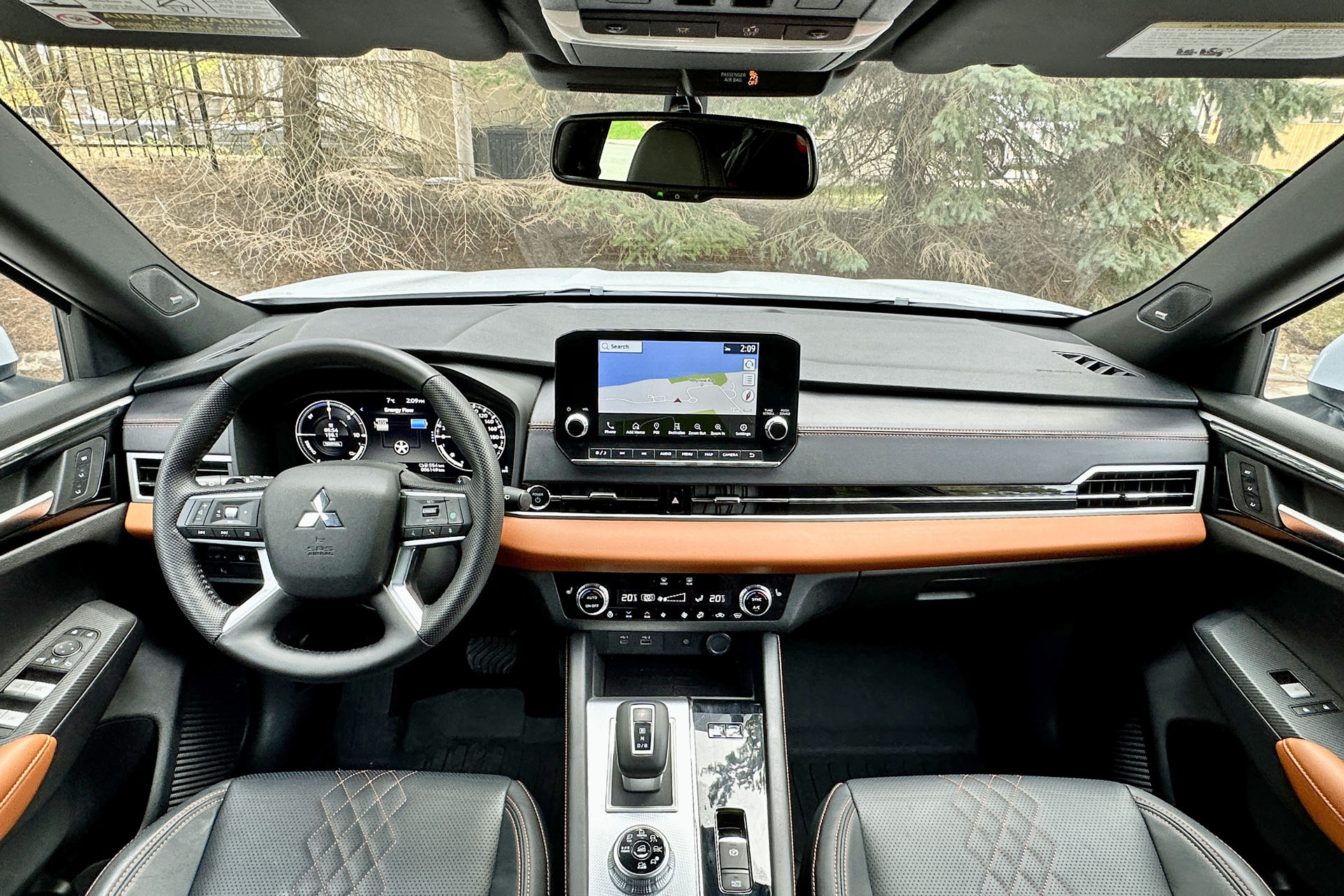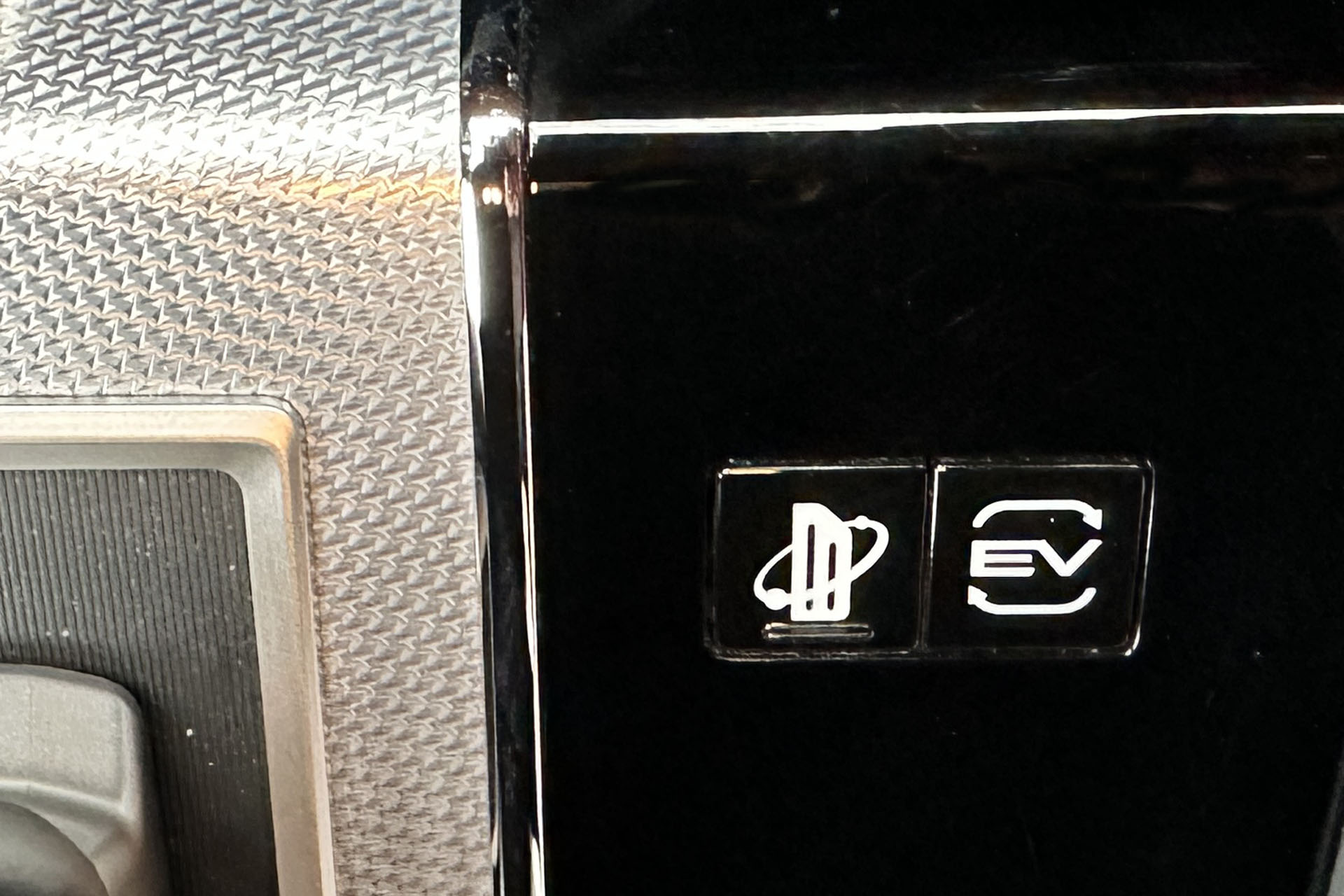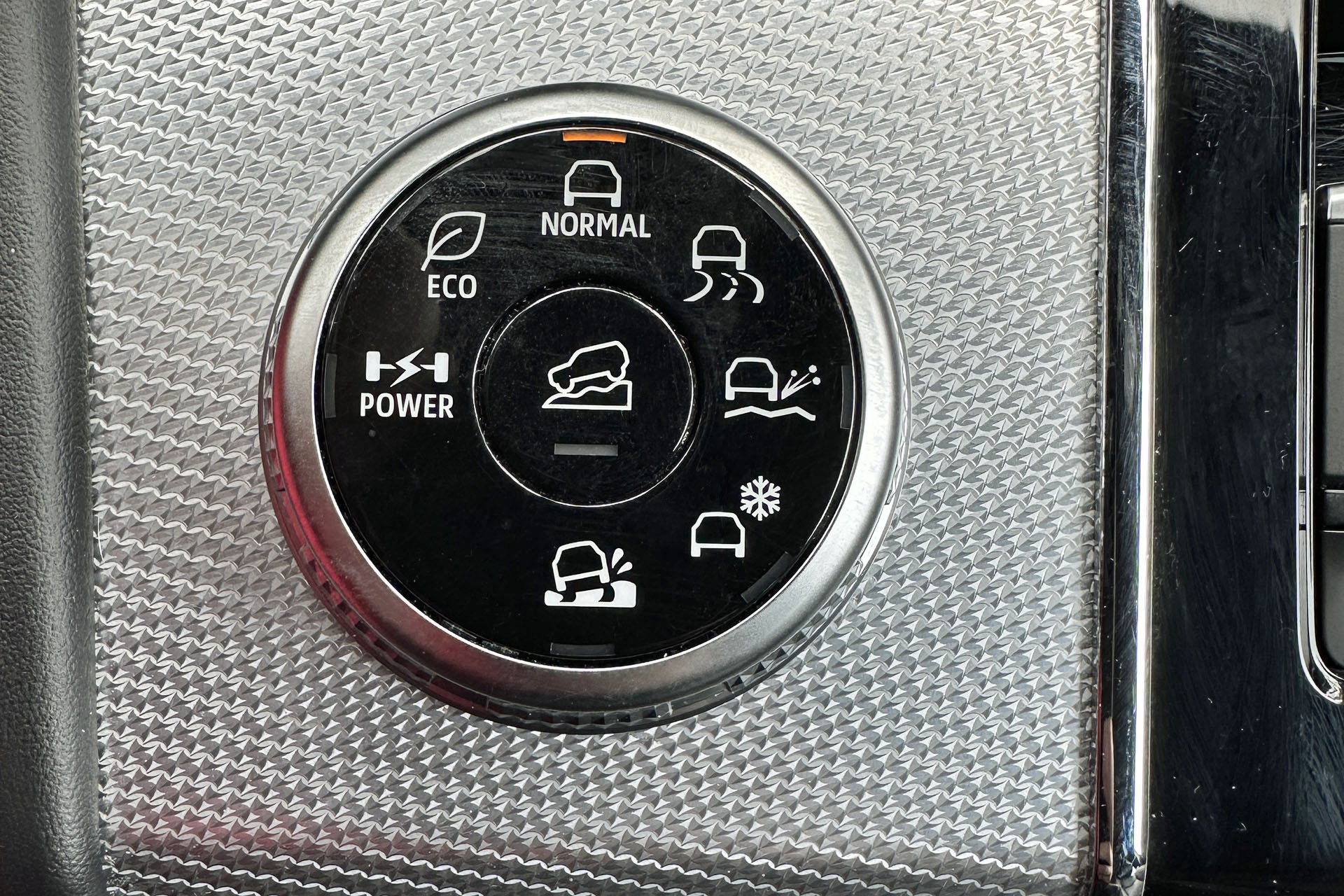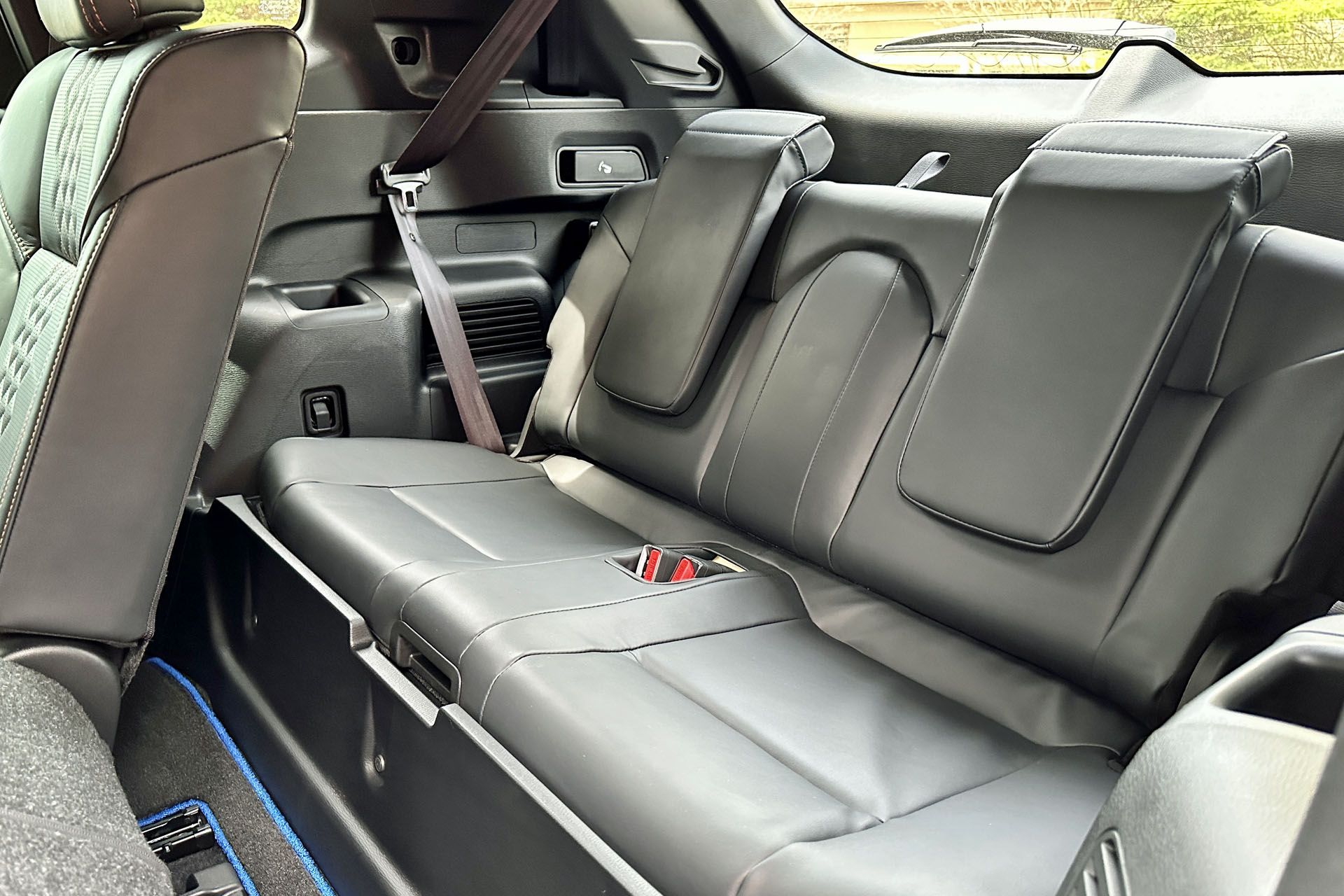Normally, a hybrid vehicle relies on the gas engine to supply the grunt and an electric motor(s) to bolster things when needed. Plug-in hybrids go one further, as the battery is large enough to deliver some real electric-only driving range. However, even PHEVs are gasoline first; electric second. Mitsubishi’s take on a hybrid for its Outlander SUV is a little different, as it can function three ways.

2023 Mitsubishi Outlander GT Premium S-AWC PHEV / Graeme Fletcher, The Charge
After a full charge the EV mode sees the battery power the electric motors without the aid of the engine. In series hybrid mode, the engine fires up to drive a generator that feeds the battery, which then powers the electric motors. This mean the electric motors are the primary motivators with gasoline being secondary.

2023 Mitsubishi Outlander GT Premium S-AWC PHEV / Graeme Fletcher, The Charge
The third mode is parallel hybrid. Here, it’s possible for the engine to drive the front wheels with help from the two electric motors. Interestingly, this mode did not kick in during the test, or at least according to the pictogram that shows how the system is functioning.

2023 Mitsubishi Outlander GT Premium S-AWC PHEV / Graeme Fletcher, The Charge
The hybrid system features a 2.4-litre four-cylinder engine that makes 131 horsepower and 144 pound-feet of torque. It works with two electric motors, one driving each axle. For 2023, both motors get more power. The front motor now makes 114 hp, which is up 34 hp, and 188 lb-ft of torque, which is up 87 lb-ft. The rear electric motor chips in with another 134 hp, which is up 44 hp and 144 lb-ft of torque, which is the same as before. When the system is at full chat it produces a net output of 248 hp and, more importantly, 332 lb-ft of torque. The performance is crisp and it delivers whenever the driver demands power — the 7.9 second run to 100 km/h is pretty quick.

2023 Mitsubishi Outlander GT Premium S-AWC PHEV / Graeme Fletcher, The Charge
To accommodate the more powerful motors, the battery has also been upsized – it’s up from 13.8 kilowatt-hours to a more substantial 20 kWh. There are three ways of keeping it charged. A Level 2 charger tops it off in 6.5 hours. A DC fast charger can pump an 80 percent charge into the battery in 38 minutes. The expensive option is using the engine to charge the battery. It takes 94 minutes of gas consumption to bring the battery to 80 per cent. However, it’s a palatable option if the Outlander is being used as a generator to power the onboard 110-volt outlets. The setup can deliver 1,500 watts of power through the two sockets.

2023 Mitsubishi Outlander GT Premium S-AWC PHEV / Graeme Fletcher, The Charge
When fully charged, the battery has an electric-only range of 61 km, so the PHEV qualifies for the full federal rebate. During the test, however, the distance-to-empty routinely showed 70 km. This was enough for my daily driving without dipping into the gas tank. Surprisingly, the system can tolerate a fairly deep stab at the accelerator before the engine does kick in. From a practical perspective, the gas engine really only came alive on a longer trip as the battery neared depletion. Even then, it was driving the generator.

2023 Mitsubishi Outlander GT Premium S-AWC PHEV / Graeme Fletcher, The Charge
The hybrid system has different modes accessed through the EV button. Normal is for everyday driving; EV gives priority to electric-only driving. Save mode conserves the battery for use at a later time. There is also the Charge mode.
Beside the EV button is another button that activates the “innovative pedal.” When active it gives the Outlander a near one-pedal drive by using a blend of regen and regular braking to slow the vehicle. In practice it slows with authority, but does not bring the Outlander to a standstill, so it’s not a true one-pedal mode. That said, kudos to Mitsubishi for putting regen braking to good use. Including another six levels of regen through the paddle shifters when the shifter is in B (brake) mode is overkill.

2023 Mitsubishi Outlander GT Premium S-AWC PHEV / Graeme Fletcher, The Charge
So far, these modes only look after the hybrid system. There are another seven modes that look after different driving scenarios. The three core modes are Eco (just too wimpy), Normal for everyday driving and Power when it’s time to have a little fun. Beyond that there are Tarmac, Gravel, Snow and Mud. All but Snow mode will likely gather dust!

2023 Mitsubishi Outlander GT Premium S-AWC PHEV / Graeme Fletcher, The Charge
The two electric motors also deliver Mitsubishi’s sophisticated Super-All Wheel Control (S-AWC) all-wheel-drive system. It not only distributes the power between the axles, it’s also used as a level of vehicle stability control. As well as sending the power to the wheels with traction it delivers brake-based torque vectoring, which helps stability and sharpens the response through a corner.

On road, the Outlander has a composed driving feel. The platform, which it shares with the Nissan Rogue, and suspension do a good job of reining in body roll without sacrificing highway comfort. It represents a big step forward. Likewise, the steering is sharp without being twitchy. While Outlander is not overtly sporty, it is a competent and accomplished drive.
Inside, the Outlander is nicely finished. The tester’s two-tone theme added some visual zing with the orange accents matching the stitching in the semi-aniline leather seats. The level of equipment is right there, too. A 12.3-inch screen displays the reconfigurable instrumentation clearly and is augmented by a good head-up display. The nine-inch infotainment screen does likewise and gives easy access to Apple CarPlay and Android Auto. The Bose sound system it supports is a good one; the TomTom navigation not so much.

2023 Mitsubishi Outlander GT Premium S-AWC PHEV / Graeme Fletcher, The Charge
Move rearward and the middle row seating is roomy and comfortable when is its rear-most position. Here, the third row is basically unusable as there is next to no legroom. You can slide the middle row forward to add third-row room, but this puts a crimp in the middle row. Think of the Outlander as a comfortable five-seater; it becomes a seven-seater when it’s raining.

2023 Mitsubishi Outlander GT Premium S-AWC PHEV / Graeme Fletcher, The Charge
The 2023 Mitsubishi Outlander PHEV is different, as it functions more like an electric vehicle with a gas-powered range-extender. It is, perhaps, fitting the badging gives the EV part of the name priority over the plug-in portion. The good news is this ability does not compromise how it drives. Yes, it’s very complicated, but the saving grace is the hybrid powertrain and battery are covered by a generous 10-year/160,000-km warranty.
The 2023 Mitsubishi Outlander PHEV starts at $46,538 for the ES S-AWC; as tested, the GT Premium Two-tone Roof S-AWC is $57,958.






